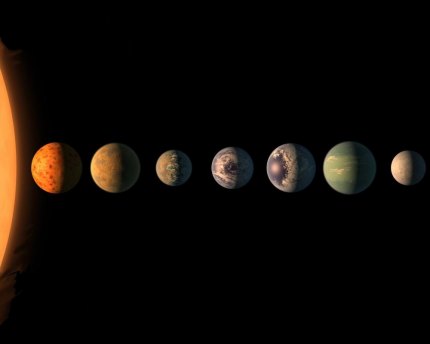
TRAPPIST-1's seven planets “appear linked in a complex dance known as an orbital resonance, where their respective orbital periods are mathematically related and slightly influence each other,” explains a University of Washington news release.
The seven-planet chain of resonance establishes a record among known planetary systems. Two other systems are known to have four planets in resonant orbit.
Curiosity about the TRAPPIST-1 system has been building since earlier this year, when scientists held a press conference to announce that three of the system’s seven planets are in the habitable zone. These planets orbit a star that is smaller and far cooler than our sun.
The system is 40 light-years or 235 trillion miles away in the constellation of Aquarius. It is named for The Transiting Planets and Planetesimals Small Telescope (TRAPPIST) in Chile.
Scientists have been using information gathered by the Kepler Space Telescope to learn about the outermost of seven exoplanets, known as TRAPPIST-1h, which orbits the star every 18 days. The planet is frigid and probably doesn’t support life, the news release said. Even so, it could have spent several hundred million years in a warmer state, when its host star was brighter.
Rodrigo Luger, doctoral student at University of Washington, is lead author of the paper “A seven-planet resonant chain in TRAPPIST-1,”published May 22 in the journal Nature Astronomy.
Earth may have started as solar doughnut: If someone mentioned the words solar doughnut, would you think they were talking about: A) A hip doughnut franchise; B) Newly developed snacks for the International Space Station crew; or C) A description of planets in the formative stage?
If you chose C, congratulations. In research published this week, scientists propose using the word synestia to describe spinning, doughnut-shaped masses of rock that are “formed as planet-sized objects smash into each other,” according to a news release from University of California at Davis.
The word synestia is the combination of the prefix syn- meaning together, and Hestia, the Greek goddess of architecture and structures. Earth may have once been a synestia.
Consider that rocky planets formed as smaller objects collided, the news release explains. After these collisions, the bodies melted and partially vaporized before cooling and solidifying to spherical planets. The new research focuses on collisions between spinning objects.
The scientists, Sarah Stewart, professor of planetary sciences and geophysics at the University of California, Davis, and Simon Lock, a graduate student at Harvard University, modeled what happens when Earth-sized rocky planets collide with other large objects with high energy and momentum.
They found that a much larger body could be formed that resembles a doughnut with the center filled in. The duration of Earth’s time as a synestia may have been short, maybe 100 years, the news release explains. After that, it would have lost heat and condensed into a solid object. Some synestias formed from larger objects could have lasted longer.
The research could also explain the formation of the moon. “Most current theories about how the moon formed involve a giant impact that threw material into orbit,” the news release explains. “But such an impact could have instead formed a synestia from which the Earth and moon both condensed.”
The paper, "The structure of terrestrial bodies: Impact heating, co-rotation limits, and synestias," is published in the Journal of Geophysical Research and written by Stewart and Lock.
Related:
Scientists find seven planets around star
Follow StudyHall.Rocks on Twitter.
If you would like to comment, give us a shout, or like us on Facebook and tell us what you think.